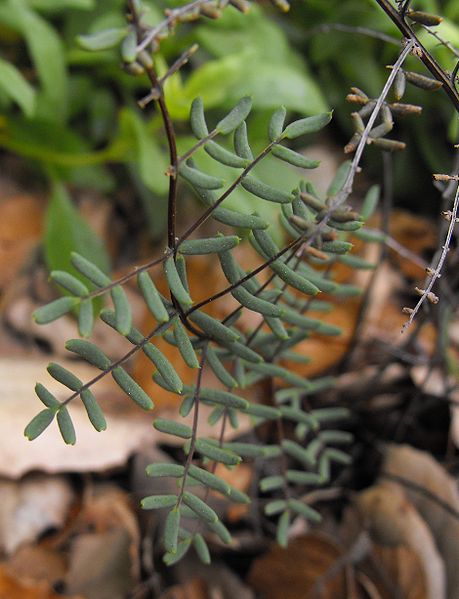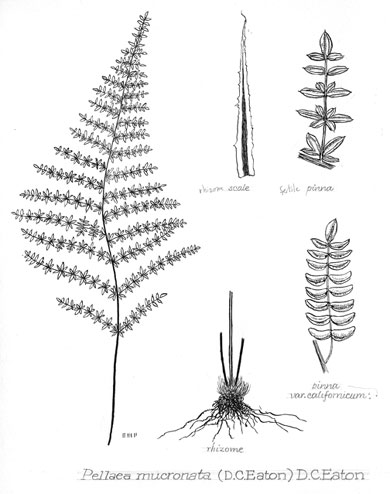|
Hardy Fern Home P. mucronata resources All Ferns � Pteridaceae �� Pellaea
�Other Genera
|
| Pellaea mucronata | ||
Bird's foot fern | ||
|
Etymology
Mucronata means having a point. See Distinctive Characteristics.
Description
Rhizome: short-creeping or erect, linear brown scales, black at a center stripe.
Frond: 40 cm high by 18 cm wide, evergreen, monomorphic, blade/stipe ratio: . Stipe: dark-brown to black, shiny, flattened to slightly grooved above, color extending the entire rachis, croziers slightly hairy, mainly glabrous, vascular bundles: 1. Blade: 2-pinnate, but lower elevation forms (see below) are more divided, lanceolate, leathery, glabrous. Pinnae: 10 to 15 pair, bluish-green, lower pinnae stalked, upper sessile, a terminal pinna like the upper lateral ones; pinnules narrowly oblong, 5 to 20 pair with a terminal segment like the pairs; the ends of the pinnules come to a sharp point (mucronate); margins usually dentate, strongly recurved; veins obscure. Sori: oblong or linearly joined, submarginal, indusium: false, inrolled margins, covering the entire lower surface, sporangia: pale brown, maturity: summer to fall. Culture
Habitat: among granitic rocks.
Distribution: mid to lower Sierra Nevada range in California.
Hardy to -15�C, USDA Zone 7.
Distinctive Characteristics
The sharp-pointed tips of the ultimate segments are diagnostic.
Synonyms
Allosorus mucronatus D. C. Eaton Pellaea ornithopus Hooker Pellaea mucronata subsp. californica (Lemmon) Windham |
|
|
Notes
Subtaxa The Flora of North America distinguishes between a more divided subspecies mucronata at lower elevations (below 1800 m)�in California and Nevada, and a higher elevation, less divided, i.e., 2-pinnate, subspecies californica. The lower elevation form is unlikely to be as hardy. Examples of both subspecies may be found among the photos.
Subtaxa The Flora of North America distinguishes between a more divided subspecies mucronata at lower elevations (below 1800 m)�in California and Nevada, and a higher elevation, less divided, i.e., 2-pinnate, subspecies californica. The lower elevation form is unlikely to be as hardy. Examples of both subspecies may be found among the photos.

Pellaea mucronata. habit, Rancho Santa Ana Botanic Gardens, Claremont, California. �Wikimedia Commons |
